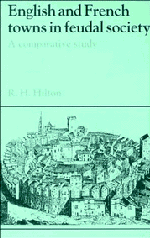5 - How urban society was imagined
Published online by Cambridge University Press: 03 May 2011
Summary
The social classes of medieval towns – or representative individuals from them – appear in the imaginative and moralising literature of the period, though not as prominently as the clergy, the knights and the peasants. The theme of social ‘orders’ or ‘estates’, which is frequently found in the literature, is mainly focussed on the three major classes of medieval agrarian society, especially those who prayed and those who fought, with a lesser role for those who toiled on the land to provide for the prayers and the fighters – who were also their landlords.
The analysis of urban structures which we have presented is based on documentary evidence generated by the economic, social and political activity of the inhabitants of the towns and the cities, just as historical research into landlords and their tenants is based on analogous evidence. But there were also images of towns and their inhabitants in imaginative and moralising writings which must be taken into account as sources for the understanding of towns in feudal society. The relevant imaginative literature, especially that of the twelfth century, consists mainly of chivalric epics and romances whose aim was the exaltation of knightly virtues, frequently within the theme of courtly love.
- Type
- Chapter
- Information
- English and French Towns in Feudal SocietyA Comparative Study, pp. 105 - 126Publisher: Cambridge University PressPrint publication year: 1992

